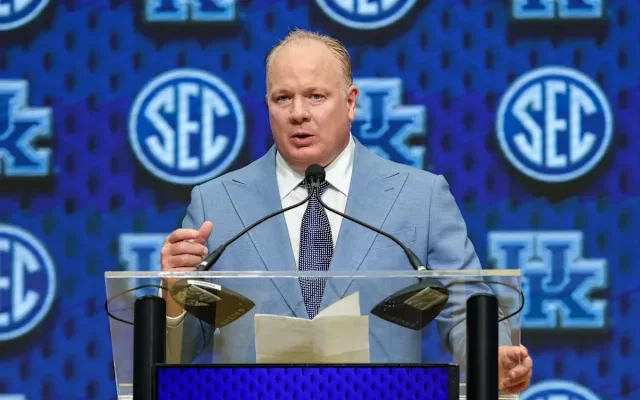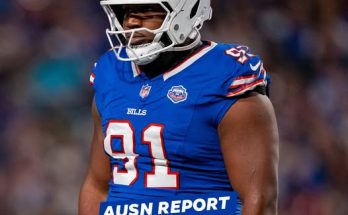Why Kentucky Football Thrived Under Mark Stoops When the Offensive Line Took Control from 2016 to 2021
Kentucky football’s most successful years under head coach Mark Stoops have shown a clear pattern: when the offensive line leads the charge, the Wildcats play at their very best. From 2016 through 2021, this unit wasn’t just a supporting cast but the backbone of Kentucky’s offense, dictating the pace of the game and providing the foundation for wins in one of college football’s toughest conferences. The strength, cohesion, and effectiveness of Kentucky’s offensive line during this period proved pivotal in elevating the program’s performance, making a compelling case for just how essential this group was to Stoops’ overall success.
Mark Stoops inherited a program that had long struggled to compete consistently in the Southeastern Conference (SEC), a league famous for its defensive intensity and physicality. Building a competitive team meant focusing on every aspect of the game, but the offensive line quickly became a major priority. In football, the offensive line often doesn’t get the spotlight it deserves, but for Kentucky, the line was the unsung hero of their climb.
The years between 2016 and 2021 saw Kentucky’s offensive line develop from a group of hopefuls into a dominant force. Their ability to control the line of scrimmage allowed the Wildcats to establish a powerful rushing attack, protect the quarterback effectively, and sustain drives that wore down some of the nation’s best defenses. In fact, it’s fair to argue that Kentucky’s offensive line was one of the most critical reasons the program reached multiple bowl games and claimed signature victories during this era.
Why did the offensive line become so essential to Kentucky’s success under Stoops? One key factor was the philosophy Stoops and his coaching staff adopted early in his tenure. They recognized that to succeed in the SEC, Kentucky needed to play physical, smash-mouth football that controlled time of possession and limited turnovers. That starts with a dominant offensive line. Recruiting and developing linemen became a priority, and Stoops invested heavily in coaches and facilities dedicated to this effort.
Kentucky’s offensive line during this period was marked by versatility and depth. The Wildcats produced linemen who could play multiple positions along the front, adapting to injuries and tactical shifts without losing performance. This adaptability was crucial, as the SEC is notorious for physical play that demands players who can endure and adjust quickly. From guards who powered run-blocking schemes to tackles who protected the blindside, Kentucky’s line formed a cohesive unit capable of setting the tone each week.
The impact of a strong offensive line extends beyond just blocking. It influences the confidence and execution of the entire offense. Quarterbacks like Terry Wilson and later Will Levis benefited from consistent pass protection, which allowed them to make accurate throws and avoid damaging sacks. Meanwhile, the running backs thrived behind lanes carved out by the line’s collective strength, producing yards after contact and breaking tackles. This synergy between line and skill positions led to offensive consistency that had been elusive for Kentucky in earlier decades.
From a strategic perspective, the offensive line’s dominance also opened the door for a more diverse offensive playbook. With reliable protection and rushing lanes, Kentucky’s coaches could design plays that incorporated play-action passes, screens, and quick throws that kept defenses guessing. This complexity made the Wildcats harder to defend and allowed them to compete with top SEC programs that boasted elite defenses.
Long-tail keywords like “Kentucky football offensive line dominance 2016-2021,” “Mark Stoops best offensive units,” and “SEC football offensive line importance” highlight how this topic resonates with football fans, analysts, and recruiting followers. Fans interested in Kentucky football’s rise, offensive line development, and Stoops’ coaching philosophy often search for detailed insights into how the Wildcats found success during this period. This article captures those interests by focusing on the tangible impact of the offensive line.
One cannot discuss Kentucky’s offensive line success without mentioning the players who emerged as leaders during this era. Linemen like Logan Stenberg, Drake Jackson, and Thoma Robinson became household names among Wildcats fans. Their performances earned conference honors and helped establish Kentucky as a destination for offensive line recruits looking to develop under a program known for its line coaching and competitive success.
Moreover, Kentucky’s offensive line success contributed to the program’s overall recruiting appeal. High school linemen across the region noticed that Kentucky was a place where they could grow, get strong coaching, and showcase their skills against elite competition. This created a virtuous cycle, bringing in better recruits who further elevated the line’s play and, by extension, the entire offense.
It’s important to acknowledge that the offensive line’s dominance was not isolated from the rest of the team. Defensive improvements and special teams also played roles in Kentucky’s success under Stoops, but the offensive line’s contributions were often the catalyst for many positive outcomes. Games where the Wildcats controlled the line of scrimmage were often games they controlled from start to finish.
In examining the impact of the offensive line from 2016 to 2021, it’s also clear that the culture Stoops built around toughness and accountability was essential. Offensive linemen at Kentucky were expected to embody grit and perseverance. They set an example in practice and games, demonstrating that the position requires both physical and mental strength. This culture contributed to on-field success and helped forge a resilient team identity.
Looking at Kentucky’s performance metrics during these years, the data supports the argument about the offensive line’s influence. The Wildcats improved their rushing yards per game, allowed fewer sacks, and maintained longer drives compared to prior seasons. These statistical improvements correlate strongly with the offensive line’s development and show how integral they were to game management and overall efficiency.
Furthermore, the offensive line’s impact on Kentucky football is still felt today. The foundation laid between 2016 and 2021 serves as a blueprint for future success. Current and incoming players have a clear model to follow, and the coaching staff continues to emphasize line play as a priority. Kentucky fans have every reason to believe that the program’s best days are ahead, fueled by lessons learned during Stoops’ peak years with a dominant offensive line.
In conclusion, the argument that Kentucky football was at its best under Mark Stoops when the offensive line led the way from 2016 to 2021 is strong and well supported. This unit’s ability to control the game’s physical and strategic aspects transformed Kentucky from a struggling program into a competitive SEC contender. The success of the offensive line helped create a sustainable culture of toughness, consistency, and adaptability that continues to define Kentucky football. For fans, recruits, and analysts alike, understanding this period is key to appreciating how Stoops and his Wildcats carved out their place in one of college football’s toughest conferences.



